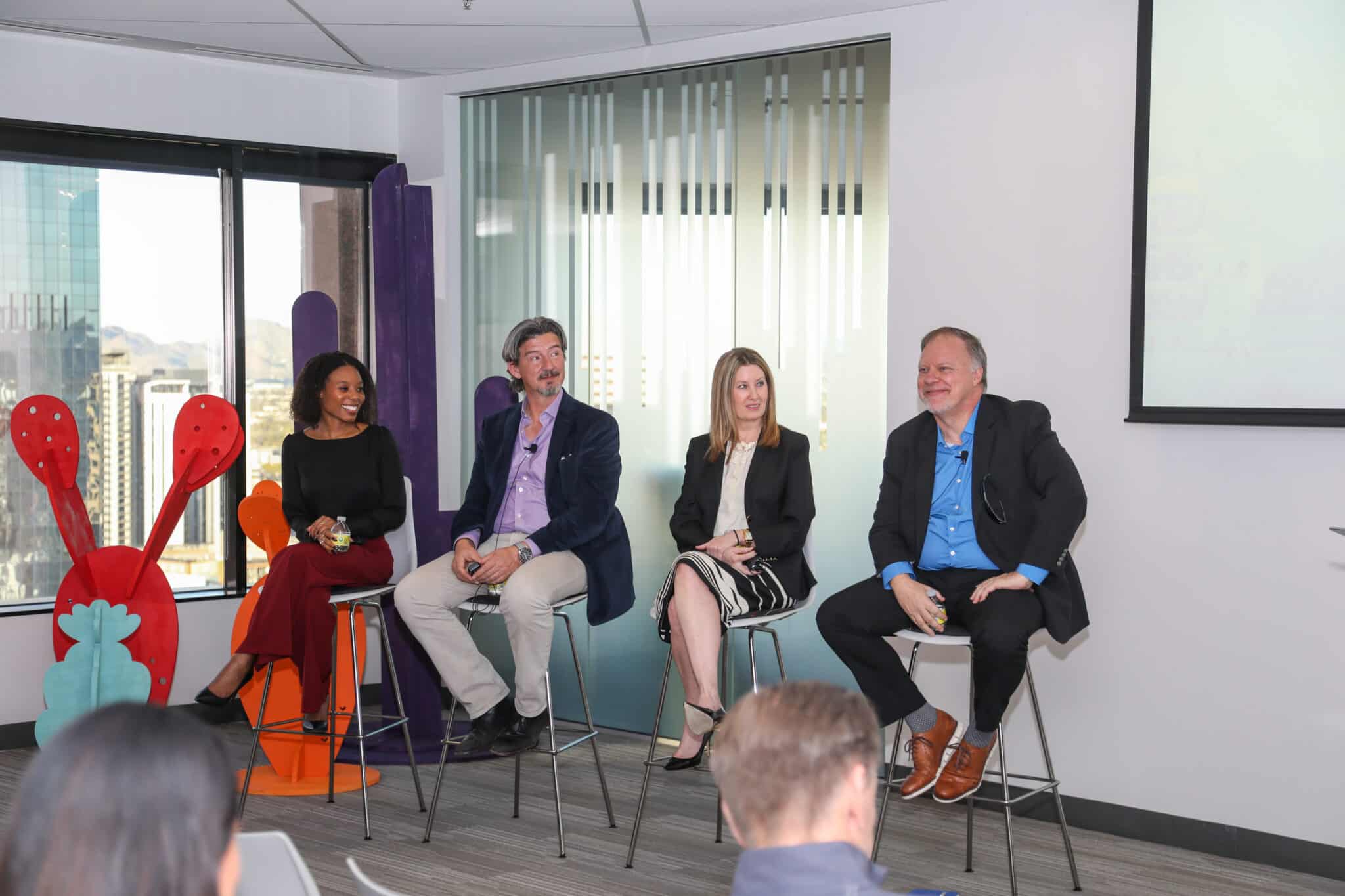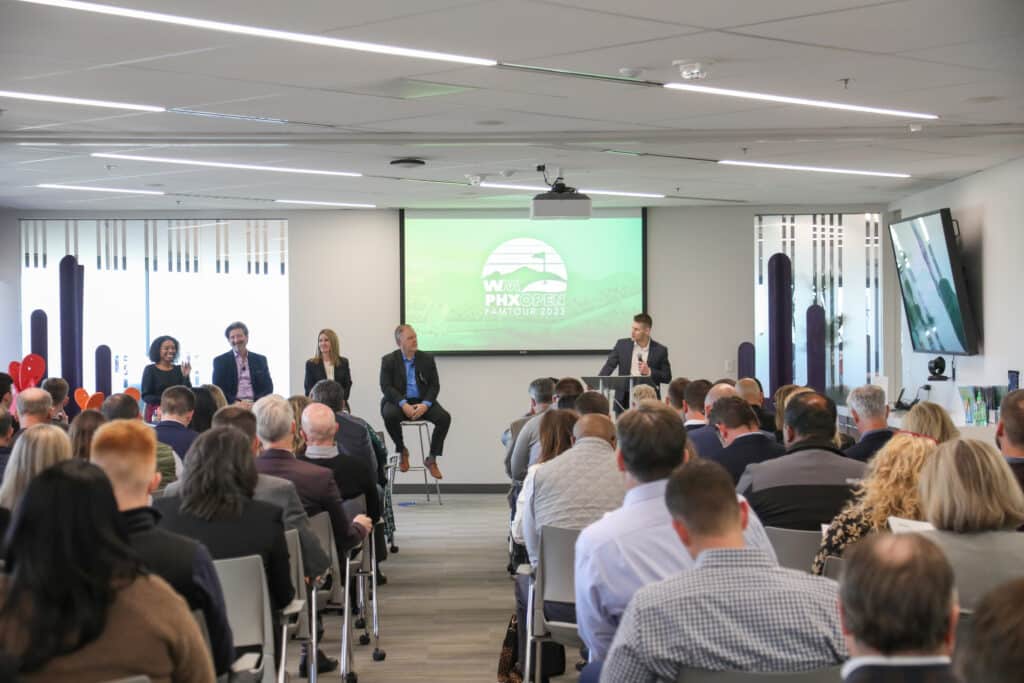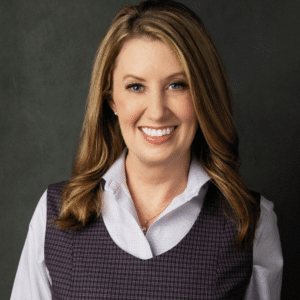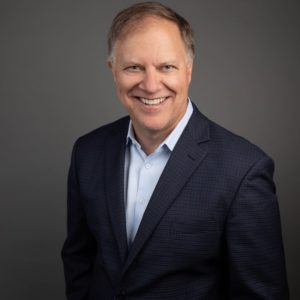

Ambassador Event: Site Selector Panel
Published: 02/27/2023
How businesses are adjusting to ESG, DEI and the post-COVID workforce
With the national economy at an inflection point, companies have shifted out of COVID-19 planning into preparation for operations in a post-pandemic landscape. As companies consider the impact of a potential recession and how to best invest in growth, workforce is top-of-mind.
A group of site selectors, who advise companies that are considering expansion or relocation, joined the Greater Phoenix Economic Council (GPEC) Ambassador Event to share insight on the priorities of businesses and adjustments they are making.
The panelists were:
- Amy Gerber, Executive Managing Director, Cushman & Wakefield
- Robert Hess, Vice Chairman, Newmark
- Nicholette Ross, Senior Consultant, Global Location Strategies
- Matt Szuhaj, Managing Director, Real Estate & Location Strategy, Deloitte
“During COVID and after COVID, I’ve never seen so much scenario planning in companies [as] right now,” Hess said.
A push toward ESG and DEI
Companies are adjusting to shifting workforce priorities to combat a labor shortage. Consultants have seen an increase in employees calling for environmental, social, and governance (ESG) goals — the application of non-financial factors into operations analysis to create objectives for the social and environmental impact a company has on its surroundings.
“Companies have figured that ‘If I’m going to attract and retain labor, I better have my ESG stuff straight. … This is a differentiator for talent,” Szuhaj said. “They have to invest in the community. You can’t just bring in jobs.”
Hess said that regions targeting international companies must take this into consideration as well. Many European countries have already implemented regulations around ESG, and foreign companies have had years to adjust mission statements and planning. Many industrial and distribution clients Gerber is working with have instituted measurable goals with developers.
“It’s actually putting things in there with milestones that have to be achieved into contract. It is very real, it’s getting bigger and bigger,” Gerber said. “We’re going to more expensive markets because they’re meeting some of the sustainability goals that our clients are looking for.”
Diversity, equity and inclusion often applies to ESG goals. Site selectors said that companies struggling with the “inclusion” aspect should look at it instead through a lens of “belonging.”
“Some of these (inclusion) programs exist, but there’s no one a part of them. They’re not showcasing the inclusion programs in the areas where they’re needed,” Ross said.
“I definitely challenge anyone that is taking part in those programs to really think about the belonging aspect of it because you want to be able to retain those people. It’s OK to have diversity, but you take it a step forward and make everyone a part of what the grand goal is for the community.”
Szuhaj said companies have started to take initiative in locations where the government has not addressed these needs.
“There’s this movement within corporations, especially in life sciences, like, ‘We’re going to be the leaders. We’re not going to wait for government to do it,’” he said.
Marketing megasites
Investing in the business and lifestyle of an area helps attract mega deals. Just because a building exists doesn’t mean the area has the workforce required; just because there’s a plot of land does not mean it is connected to the necessary infrastructure and power.
A megasite shouldn’t only be available — it should be ready.
“It comes down to all the things you do every day for non-mega-deals: You need the people, the infrastructure and the connectivity,” Gerber said. “Are you willing to put that investment, anticipating that next deal coming down the road? … You’re going to have to have that community — honestly that region — that’s going to be willing to stick in the deal for a long time.”
Incentives and remote work
States differ on their plans to address job-based incentive packages for companies that hire remote workers. The economic impact that jobs have on a region changes based on where the employees live; while some states are incentivizing companies to keep employees in-office or in-region, other states are trying to incentivize people to move into their markets.
“I think one of the two will have to happen in most areas,” Ross said.
Ross said she does not expect remote work to decrease. Incentives, which come with the expectation that a business investment will have a ripple effect on the broader region, must be calculated in accordance with new workforce lifestyle norms.
“When you look at certain parts of different states and cities where restaurants and retail establishments only survive by daytime foot traffic and that doesn’t happen, there’s a bigger picture than giving flexibility to employees,” Gerber said. “If I was a city and I had a budget with most of my revenues coming from sales tax, I’d be very concerned.”
Looking forward
While businesses and economists are working to project economic changes in the short- and long-term, Hess said he believes a soft landing will come instead of a hard recession. His clients face opportunities in a world advancing toward emerging technology and digital footprints with the offer of incentives and federal funding.
“There are some trade winds and headwinds right now, you just got to know which way you can turn the sail,” Hess said. “I think this all boils down to whether you’re an optimist and you see innovation and opportunity, or whether you’re a pessimist and you die on the vine by two-week projections on your financials.”
Meet the Panel
Amy Gerber
Executive Managing Director
Business Incentives Practice
Robert Hess
Vice Chairman, Global Corporate Services
Newmark
Nicholette Ross
Senior Consultant
Global Location Strategies
Matt Szuhaj
Managing Director
Deloitte Consulting Real Estate & Location Strategy
Zach Venvertloh
(Moderator)
Director, Business Development
Greater Phoenix Economic Council





